13.1: The History of Unions
13.1.1: Organized Labor
A union is an organization of workers who have come together to achieve work related goals, such as higher pay and better conditions.
Learning Objective
Explain the basic function of a labor union
Key Points
- Through its leadership, labor unions bargain with the employers on behalf of union members and negotiates labor contracts with employers.
- Union members, employers, and sometimes non-members are bound to the final negotiated agreement.
- In addition to their collective bargaining activities, labor unions provide benefits to their members, organize industrial actions, and participate in political activities.
- Labor union density has declined in recent decades, particularly in the private sector.
Key Terms
- labor union
-
A continuous association of wage-earners for the purpose of maintaining or improving the conditions of their employment; a trade union.
- collective bargaining
-
A method of negotiation in which employees negotiate as a group with their employers, usually via a trade union
Example
- An early example of a labor union is the Knights of Labor. The Noble and Holy Order of the Knights of Labor (KOL) was founded in Philadelphia in 1869 by Uriah Stephens and six other men. The union was formed for the purpose of organizing the flyers and educating and directing the power of the industrial masses, according to their constitution of 1878. The union grew slowly until the economic depression of the 1870s, when large numbers of workers joined the organization. The Knights only permitted certain groups of individuals into their order which promoted social division amongst the people around them. Bankers, speculators, lawyers, liquor dealers, gamblers, and teachers were all excluded from the union. These workers were known as the “non-producers,” because their jobs did not entail physical labor. Factory workers and business men were known as the “producers,” because their job constructed a physical product. The working force producers were welcomed into the order. Women were also welcome to join the Knights, as well as black workers by the year 1883. However, Asians were excluded. In November 1885, the Knights of a Washington city pushed to get rid of their Asian population. The Knights were strongly for the Chinese Exclusion Act of 1882 because it greatly helped them deteriorate the Asian community.
Labor Unions
A labor union is an organization of workers that have banded together to achieve common goals, such as higher pay, increasing the number employees an employer hires, and better working conditions. The trade union, through its leadership, bargains with the employer on behalf of union members (rank and file members) and negotiates labor contracts (collective bargaining) with employers. Other actions may include the negotiation of:
- Wages
- Work rules
- Complaint procedures
- Rules governing hiring
- Firing and promotion of workers
- Benefits
- Workplace safety and policies
The agreements negotiated by the union leaders are binding on the rank and file members and the employer and in some cases, on other non-member workers. Union officials can force compulsory union dues from employees, members and nonmembers alike, as a condition for keeping their jobs.
Additional Labor Union Activities
Aside from collective bargaining, activities vary but may include:
- Provision of benefits to members: Early trade unions often provided a range of benefits to insure members against unemployment, ill health, old age, and funeral expenses. In many developed countries, these functions have been assumed by the state; however, the provision of professional training, legal advice and representation for members is still an important benefit of trade union membership.
- Industrial action: Trade unions may enforce strikes or resistance to lock outs in furtherance of particular goals.
- Political activity: Trade unions may promote legislation favorable to the interests of their members or workers as a whole. To this end they may pursue campaigns, undertake lobbying, or financially support individual candidates or parties for public office. In some countries, trade unions may be invited to participate in government hearings about educational or other labor market reforms.
Unions, Wages, and the Future
Unions have generally won higher wages and better working conditions for their members. However, the increase in the salaries is said to have reduced the number of jobs available for union members. Since the 1970s, the proportion of employees who are part of unions has been on a steady decline. Some business thinkers believe that improvement in minimum wage and safety regulations has reduced the need for unions to negotiate.
Unions seem to do better in regulated, monopolistic environments. Economic surveys show that union negotiate salaries that are 15% to 20% higher than nonunion salaries.
Percent of Industries Unionized (USA)
- Public Sector, 37.4
- Private Sector, 7.2
- Life, Physical, and Social Science, 1
- Community and Social Service,, 16.1
- Education, Training, and Library, 38.1
- Health Care Practitioner and Technical, 13.6
- Health Care Support, 35.6
- Protective Service, 35.6
- Building, Grounds Cleanings, and Maintenance, 11.3
- Office and Administrative Support, 10.3
- Construction and Extraction, 21
- Installation, Maintenance, and Repair, 16.4
- Production, 16.6
- Transportation and Material Moving, 18.2
Trade union density will vary according to country as well.
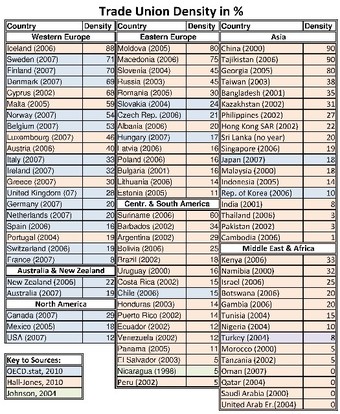
Trade Union Density in Different Countries (%)
The density of trade unions in different countries.
13.1.2: A Brief History of Organized Labor
The union movement began in the early 19th century and paved the way for the establishment of the modern labor organizations.
Learning Objective
Outline the increases and declines in the labor union movement of the last 150 years
Key Points
- A large-scale consolidation of unions took place in the 1870s and 1880s. The Knights of Labor became a major force in the late 1880s until its collapse. The American Federation of Labor (AFL) proved to be more durable.
- Unions grew rapidly from 1900-1919. This period was followed by a long decline. It was brought back to life by the Wagner Act of 1935. During this period, it became normal to find unions in heavy industry.
- The image of the labor movement was damaged in the 1950s by reports of corruption in its ranks. Labor unions had already been weakened by the introduction of the Taft-Hartley Act of 1947. Union membership in the US was at its highest in 1954, before steady decline in recent decades.
- Union membership in the US was at its highest in 1954.
- The history of workers in relation to organized labor has emerged as an area of scholarly interest.
Key Terms
- The Knights of Labor
-
The Knights of Labor (K of L) (officially “Noble and Holy Order of the Knights of Labor”) was the largest and one of the most important American labor organizations of the 1880s.
- American Federation of Labor
-
The American Federation of Labor (AFL) was one of the first federations of labor unions in the United States. It was founded in Columbus, Ohio in December 1886 by an alliance of craft unions disaffected from the Knights of Labor, a national labor association.
- CIO
-
Congress of Industrial Organizations, a former United States trade union federation (also known as the Committee of Industrial Organization) that merged with the American Federation of Labor to form the AFL-CIO in 1955
Example
- The Noble and Holy Order of the Knights of Labor (KOL) was founded in Philadelphia in 1869 by Uriah Stephens and six other men. The union was formed for the purpose of organizing the flyers, educating and directing the power of the industrial masses, according to their Constitution of 1878. The union grew slowly until the economic depression of the 1870s, when large numbers of workers joined the organisation. The Knights only permitted certain groups of individuals into their Order which promoted social division amongst the people around them. Bankers, speculators, lawyers, liquor dealers, gamblers, and teachers were all excluded from the union. These workers were known as the “non-producers” because their jobs did not entail physical labour. Factory workers and business men were known as the “producers” because their job constructed a physical product. The working force producers were welcomed into the Order. Women were also welcome to join the Knights, as well as black workers by the year 1883. However, Asians were excluded. In November 1885, the Knights of a Washington city pushed to get rid of their Asian population. The knights were strongly for the Chinese Exclusion Act of 1882 because it greatly helped them deteriorate the Asian community.
The Emergence of Umbrella Unions
Unions started emerging in the mid-19th century. The 1870s and 1880s saw large-scale consolidation, with the Knights of Labor quickly becoming a major force in the late 1880s before collapsing due to poor organization. The American Federation of Labor (AFL), led by Samuel Gompers until his death in 1924, proved much more durable. It was a coalition of many national unions, and helped resolve jurisdictional disputes, created citywide coalitions that helped coordinate strikes, and after 1907 became a player in national politics, usually on the side of the Democrats.
Rapid growth came in 1900-1919, but was followed by a long decline until the Wagner Act of 1935 led to an invigoration of the labor movement, a development that finally became a permanent factor in the heavy industry. The CIO under John L. Lewis split off and competed aggressively for membership. The AFL was always larger and both federations grew enormously during World War II. After the Communists in the CIO were purged in 1946-1948, a merger into the AFL-CIO became possible in 1955.
The Strength of Labor Unions
The Taft-Hartley Act of 1947 was a conservative measure that weakened the unions, and highly publicized reports of corruption in the Teamsters and other unions hurt the image of the labor movement during the 1950s. Unions formed a backbone element of the New Deal Coalition and of Modern liberalism in the United States. The percentage of workers belonging to a union (or “density”) in the United States peaked in 1954 at almost 35% and the total number of union members peaked in 1979 at an estimated 21.0 million. Membership has declined since (currently 14.8 million and 12% of the labor force). Private sector union membership then began a steady decline that continues into the 2010s, but the membership of public sector unions grew steadily (now 37%).
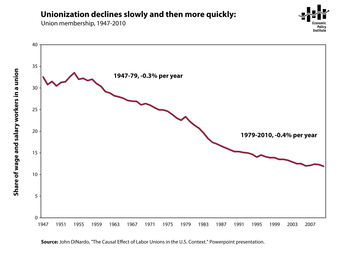
Union membership, 1947-2010
The graph shows steadily declining union membership in the last 6 decades.
Pressures dictating the nature and power of organized labor have included the evolution and power of the corporation, efforts by employers and private agencies to limit or control unions, and U.S. labor law. As a response, organized unions and labor federations have competed, evolved, merged, and split against a backdrop of changing social philosophies and periodic federal intervention.
As commentator E. J. Dionne has noted, the union movement has traditionally espoused a set of values—solidarity being the most important, the sense that each should look out for the interests of all. From this followed commitments to mutual assistance, to a rough-and-ready sense of equality, to a disdain for elitism, and to a belief that democracy and individual rights did not stop at the plant gate or the office reception room. Dionne notes that these values are “increasingly foreign to American culture”… “Labor-based political parties have been an important electoral force in every advanced capitalist country. Every one, that is, except the United States. Elsewhere, these parties were established in the late nineteenth or early twentieth centuries, and, ever since, there has been a great debate about why the American experience was different. “
Current Labor Union Studies
The history of organized labor has been a specialty of scholars since the 1890s, and has produced a large amount of scholarly literature. In the 1960s, as social history gained popularity, a new emphasis emerged on the history of workers, with special regard to gender and race. This is called “the new labor history”. Much scholarship has attempted to bring the social history perspectives into the study of organized labor.
13.1.3: Modern Labor Organizations
Labor unions have lost power in the United States over the years and, today, union membership varies by sector.
Learning Objective
Analyze the current state of labor unions
Key Points
- Today, most labor unions in the United States are members of one of two larger umbrella organizations.
- Unions have become an issue in the 2008-10 economic crisis, with the two of the largest automakers receiving $85 billion in loans in order to stay viable.
- Union membership had been declining in the United States since 1954. In 2007, the labor department reported the first increase in union memberships in 25 years and the largest increase since 1979.
- The U.S. Bureau of Labor Statistics’ most recent survey indicates that union membership in the has risen to 12.4% of all workers, from 12.1% in 2007. For a short period, private sector union membership rebounded, increasing from 7.5% in 2007 to 7.6% in 2008. However, that trend has since reversed.
Key Term
- National Labor Relations Act
-
An act to diminish the causes of labor disputes burdening or obstructing interstate and foreign commerce, to create a National Labor Relations Board, and for other purposes.
Example
- The American Federation of Labor (AFL) was one of the first federations of labor unions in the United States. It was founded in Columbus, Ohio in December 1886 by an alliance of craft unions disaffected from the Knights of Labor, a national labor association. Samuel Gompers of the Cigar Makers’ International Union was elected president of the Federation at its founding convention and was reelected every year except one until his death in 1924. The AFL was the largest union grouping in the United States for the first half of the twentieth century, even after the creation of the Congress of Industrial Organizations (CIO) by unions that were expelled by the AFL in 1935 over its opposition to industrial unionism. In 1955, the AFL merged with its longtime rival, the CIO, to form the AFL-CIO, a federation which remains in place to this day. Together with its offspring, the AFL has comprised the longest lasting and most influential labor federation in the United States.
What Are the Major Labor Unions?
Today, most labor unions in the United States are members of one of two larger umbrella organizations:
- The American Federation of Labor–Congress of Industrial Organizations (AFL-CIO); or
- The Change to Win Federation, which split from the AFL-CIO in 2005-2006.
Both organizations advocate policies and legislation favorable to workers in the United States and Canada, and take an active role in politics favoring the Democratic party but not exclusively so.
The AFL-CIO is especially concerned with global trade and economical issues.
How Are Labor Unions Regulated?
- Private sector union members are tightly regulated by the National Labor Relations Act (NLRA), passed in 1935.
- Public sector unions are regulated partly by federal and partly by state laws.
What is the State of Labor Union Membership Today?
Union membership had been declining in the United States since 1954. In 2007, the labor department reported the first increase in union memberships in 25 years and the largest increase since 1979.
Most of the recent gains in union membership have been in the service sector, while the number of unionized employees in the manufacturing sector has declined. Most of the gains in the service sector have come in West Coast states like California where union membership is now at 16.7%, compared with a national average of about 12.1%.
Historically, the rapid growth of public employee unions since the 1960s has served to mask an even more dramatic decline in private-sector union membership. Although most industrialized countries have seen a drop in unionization rates, the drop in union density (the unionized proportion of the working population) has been more significant in the United States than elsewhere.
In general the public sector unions have shown robust growth rates because wages and working conditions are set through negotiations with elected local and state officials. In such settings, the unions’ political power thus comes into play. Unlike corporations, the local government cannot threaten to move elsewhere, nor is there any threat from foreign competition.
How Does the Public View Labor Unions?
Public approval of unions climbed during the 1980s much as it did in other industrialized nations, but declined to below 50% for the first time in 2009 during the Great Recession.
It’s not clear if this is a long-term trend or a function of a high unemployment rate, which historically correlates with lower public approval of labor unions.
One explanation for loss of public support is simply the lack of union power. No longer do a sizable percentage of American workers belong to unions or have family members who do. Unions no longer carry the “threat effect:” the power of unions to raise wages of non-union shops by virtue of the threat of unions to organize those shops.
Unions have become an issue in the 2008-10 economic crisis with the two of the largest automakers receiving $85 billion in loans in order to stay viable. Some conservatives have blamed the near bankruptcy on unions and their costly labor agreements, including pension and health plans that put the U.S. automakers at a disadvantage to foreign companies. Others point out that the United Auto Workers has made extensive concessions to the car companies over the last 20 years in order to help the companies remain competitive, and allege that the automakers’ recent troubles are better ascribed to other factors.
How Did Ronald Reagan’s Influence Union Membership?
Most unions were strongly opposed to Reagan in the 1980 presidential election.
On August 3, 1981, the Professional Air Traffic Controllers Organization (PATCO) union—which had supported Reagan—rejected the government’s pay raise offer and sent its 16,000 members out on strike shutting down the nation’s commercial airlines. They demanded a reduction in the work week to 32 from 40 hours, doubling of wages, a $10,000 bonus, and early retirement.
Federal law forbade such a strike, and the Transportation Department implemented a backup plan (of supervisors and military air controllers) to keep the system running. The strikers were given 48 hours to return to work, otherwise they would be fired and banned from ever again working in a federal capacity.
A fourth of the strikers came back to work, but 13,000 did not. The strike collapsed, PATCO vanished, and the union movement as a whole suffered a major reversal, which accelerated the decline of membership across the board in the private sector.
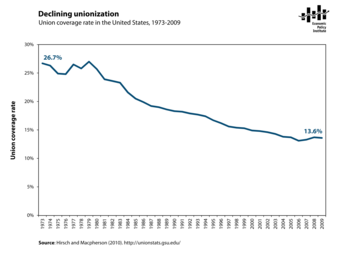
Union coverage rate in the United States, 1973-2009
13.2: Organized Labor and Related Laws
13.2.1: Norris–La Guardia Act
The Norris–LaGuardia Act removed certain legal and judicial barriers against the activities of organized labor in the United States.
Learning Objective
Explain the formation of the Norris-LaGuardia Act
Key Points
- The three provisions of the act include protecting workers’ rights to self-organization and liberty, removing nonviolent labor dispute jurisdiction from federal courts, and outlawing the “yellow dog” contract that prohibited a worker from joining a labor union as a term of employment.
- The Supreme Court held that the act prohibits employers from barring the peaceful dissemination of information concerning the terms and conditions of employment by those involved in an active labor dispute, even when such dissemination occurs on employer property.
- George William Norris was a Republican U.S. politician from Nebraska and a leader of progressive and liberal causes in Congress. Fiorello Henry LaGuardia was a Republican Mayor of New York who was elected to Congress and was able to appeal across party lines to achieve popularity.
- Fiorello Henry LaGuardia (1882 – 1947) was Mayor of New York for three terms from 1934 to 1945 as a Republican who appealed across party lines and heavily supported President Franklin D. Roosevelt as a New Dealer. He is acclaimed as one of the greatest mayors in American history.
Key Terms
- injunction
-
A writ or process, granted by a court of equity, and, in some cases, under statutes, by a court of law, whereby a party is required to do or to refrain from doing certain acts, according to the exigency of the writ.
- yellow-dog contracts
-
An agreement between an employer and an employee in which the employee agrees, as a condition of employment, not to be a member of a labor union. Such contracts were used in the U.S until the 1930s to prevent the formation of unions, most often by permitting employers to take legal action against union organizers.
Example
- Section 13A of the Norris-La Guardia Act was fully applied by the Supreme Court of the United States in New Negro Alliance v. Sanitary Grocery Co., in which, in an opinion authored by Justice Owen Roberts, the Court held that the act meant to prohibit employers from proscribing the peaceful dissemination of information concerning the terms and conditions of employment by those involved in an active labor dispute, even when such dissemination occurs on employer property.
The Norris–LaGuardia Act (also known as the Anti-Injunction Bill) was a 1932 United States federal law that banned yellow-dog contracts, barred federal courts from issuing injunctions against nonviolent labor disputes, and created a positive right of noninterference by employers against workers joining trade unions. The common title followed from the names of the sponsors of the legislation: Senator George W. Norris of Nebraska and Representative Fiorello H. La Guardia of New York, both Republicans.
The Act stated that yellow-dog contracts were unenforceable in federal court. It also established as United States law that employees should be free to form unions without employer interference, and also withdrew from the federal courts jurisdiction relative to the issuance of injunctions in nonviolent labor disputes. No federal court can offer jurisdiction. The three provisions include protecting worker’s self-organization and liberty, removing jurisdiction from federal courts, and outlawing the “yellow dog” contract.
Section 13A of the act was fully applied by the Supreme Court of the United States in New Negro Alliance v. Sanitary Grocery Co., in which the Court held that the Act prohibits employers from barring the peaceful dissemination of information concerning the terms and conditions of employment by those involved in an active labor dispute, even when such dissemination occurs on employer property.
The Authors of the Act
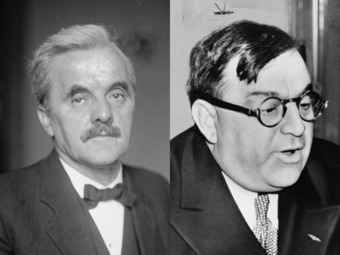
George Norris and Fiorello LaGuardia
Senator George W. Norris and Representative Fiorello H. LaGuardia were the chief sponsors of the Act.
George William Norris (1861 – 1944) was a U.S. politician from the state of Nebraska and a leader of progressive and liberal causes in Congress. He served five terms in the United States House of Representatives as a Republican from 1903 until 1913 and five terms in the United States Senate from 1913 until 1943, four terms as a Republican and the final term as an Independent.
Fiorello Henry LaGuardia (1882 – 1947) was Mayor of New York for three terms from 1934 to 1945 as a Republican. Previously he was elected to Congress in 1916 and 1918, and again from 1922 through 1930. He is often acclaimed as one of the three or four greatest mayors in American history. Only five feet tall, he was called “the Little Flower”. LaGuardia was a Republican who appealed across party lines, was very popular in New York during the 1930s. As a New Dealer, he supported President Franklin D. Roosevelt, a Democrat, and in turn Roosevelt heavily funded the city and cut off patronage from LaGuardia’s foes. La Guardia revitalized New York City and restored public faith in City Hall.
13.2.2: National Labor Relations Act
The National Labor Relations Act limits employers’ relations to workers who create labor unions and collectively act in support of demands.
Learning Objective
Analyze the controversy behind the National Labor Relations Act
Key Points
- The act encourages the practice of collective bargaining by protecting workers’ freedom of association, self-organization, and designation of representatives of their own choosing.
- The NLRA was controversial and employers campaigned to outlaw a number of union practices such as closed shops, secondary boycotts, jurisdictional strikes, mass picketing, and strikes.
- The Taft-Hartley Act amended the National Labor Relations Act. It was seen as a means of demobilizing the labor movement by imposing limits on labor’s ability to strike and by prohibiting radicals from their leadership.
- The Taft-Hartley Act is a United States federal law, which amended the National Labor Relations Act, that monitors the activities and power of labor unions. The Taft–Hartley Act was seen as a means of demobilizing the labor movement by imposing limits on labor’s ability to strike and by prohibiting radicals from their leadership. The Taft–Hartley Act prohibited jurisdictional strikes, wildcat strikes, solidarity or political strikes, secondary boycotts, secondary and mass picketing, closed shops, and monetary donations by unions to federal political campaigns.
Key Terms
- National Labor Relations Act
-
An act to diminish the causes of labor disputes burdening or obstructing interstate and foreign commerce, to create a National Labor Relations Board, and for other purposes.
- wildcat strikes
-
A strike action taken by workers without the authorization of their trade union officials. The Memphis Sanitation Strike and the Baltimore Municipal Strike of 1974 started as wildcat strikes, only to later be supported by the union.
The National Labor Relations Act (NLRA) is a 1935 United States federal law that limits the means with which employers may react to workers in the private sector who create labor unions, engage in collective bargaining, and take part in strikes and other forms of concerted activity in support of their demands. It was signed into law by President Franklin D. Roosevelt.
The law holds that wildcat strikes are illegal, and that workers must formally request that the National Labor Relations Board end their association with their labor union if they feel that the union is not sufficiently supportive of them before they can legally go on strike.
Key Principles of the NLRA
The key principles of the NLRA include:
- Encouraging the practice and procedure of collective bargaining by protecting the exercise by workers of full freedom of association, self-organization, and designation of representatives of their own choosing.
- Protecting a wide range of activities, whether a union is involved or not, in order to promote organization and collective bargaining.
- Protecting employees as a class and expressly not on the basis of a relationship with an employer.
The law originally defined and prohibited five unfair labor practices:
- Interfering with, restraining, or coercing employees in their rights, including freedom of association; mutual aid or protection; self-organization; the right to form, join, or assist labor organizations; the right to bargain collectively for wages and working conditions through representatives of their own choosing; and the right to engage in other protected concerted activities with or without a union.
- “Dominating” or interfering with the formation or administration of any labor organization.
- Discriminating against employees to encourage or discourage acts of support for a labor organization.
- Discriminating against employees who file charges or testify.
- Refusing to bargain collectively with the representative of the employer’s employees.
Controversy
The American Liberty League, an organization made up of conservatives, viewed the act as a threat to freedom and engaged in a campaign of opposition in order to repeal these “socialist” efforts. This campaign continued until the NLRA was found constitutional by the Supreme Court in 1937. As time went by, employers and their allies in Congress also criticized the NLRA for its expansive definition of “employee” and for allowing supervisors and plant guards to form unions, sometimes affiliated with the unions that represented the employees whom they were supposed to supervise or police.
Many accused the NLRB of a general pro-union and anti-employer bias. In addition, employers campaigned over the years to outlaw a number of union practices such as closed shops; secondary boycotts; jurisdictional strikes; mass picketing; strikes in violation of contractual no-strike clauses; pension, health, and welfare plans sponsored by unions; and multi-employer bargaining.
The Taft-Hartley Amendment
The Taft-Hartley Amendment of 1947 is a United States federal law that monitors the activities and power of labor unions. The act was a means of demobilizing the labor movement by imposing limits on labor’s ability to strike and by prohibiting radicals from their leadership.
The Taft–Hartley Act prohibited jurisdictional strikes, wildcat strikes, solidarity or political strikes, secondary boycotts, secondary and mass picketing, closed shops, and monetary donations by unions to federal political campaigns. It also required union officers to sign non-communist affidavits with the government. The act authorized the President to intervene in strikes or potential strikes that create a national emergency, a reaction to the national coal miners’ strikes called by the United Mine Workers of America in the 1940s.
The act was sponsored by Senator Robert Taft and Representative Fred A. Hartley, Jr. It became law by overriding U.S. President Harry S. Truman’s veto on June 23, 1947; labor leaders called it the “slave-labor bill,” while President Truman argued that it was a “dangerous intrusion on free speech,” and that it would “conflict with important principles of our democratic society. “
Nevertheless, Truman would subsequently use it twelve times during his presidency. President George W. Bush invoked the law most recently in connection with the employer lockout of the International Longshore and Warehouse Union during negotiations with West Coast shipping in 2001.
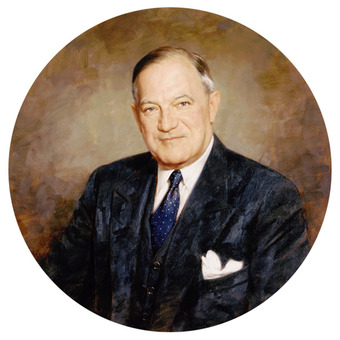
Democratic Senator Robert F. Wagner
Sponsor of the National Labor Relations Act/Wagner Act.
13.2.3: Fair Labor Standards Act
The Fair Labor Standards Act (FLSA) established a national minimum wage, “time-and-a-half” for overtime in certain jobs, and etc.
Learning Objective
Outline the application of the Fair Labor Standard Act
Key Points
- The Fair Labor Standards Act established a national minimum wage, guaranteed “time and a half” for overtime in certain jobs, and prohibited most employment of minors in “oppressive child labor”.
- The 1947 Portal-to-Portal Act specified exactly what type of time was considered compensable work time.
- The Fair Labor Standards Amendment included changes to overtime compensation, defined a “regular rate,” raised the minimum wage from 40 cents to 75 cents per hour and extended child labor coverage.
- Generally, employees of a company that does at least $500,000 of business or gross sales in a year will be subject to the FLSA’s protections.
- Several exemptions to the FLSA exist that relieve an employer from having to meet the statutory minimum wage, overtime, and record-keeping requirements. The largest exceptions apply to the so-called “white collar” exemptions that are applicable to professional, administrative and executive employees. Exemptions are narrowly construed; an employer must prove that the employees fit “plainly and unmistakeably” within the exemption’s terms.
- The FLSA applies to “any individual employed by an employer” but not to independent contractors or volunteers because they are not considered “employees” under the FLSA. Still, an employer cannot simply exempt workers from the FLSA by calling them independent contractors, and many employers have illegally misclassified their workers as independent contractors. Courts will look at the “economic reality” of the relationship between the putative employer and the worker to determine whether the worker is, in fact, an independent contractor.
Key Terms
- independent contractor
-
A person working independently, under a contract; a self-employed person.
- overtime
-
The rate of pay, usually higher, for work done outside of or in addition to regular hours.
- minimum wage
-
The lowest rate at which an employer can legally pay an employee; usually expressed as pay per hour.
It established a national minimum wage, guaranteed “time and a half” for overtime in certain jobs and prohibited most employment of minors in “oppressive child labor. ” Children under the age of 18 cannot do certain dangerous jobs, and children under the age of 16 cannot work. 700,000 workers were affected by the FLSA.
Amendments
The 1947 Portal-to-Portal Act specified exactly what type of time was considered compensable work time. In general, as long as an employee is engaging in activities that benefit the employer, regardless of when they’re performed, the employer has an obligation to pay the employee for his or her time. It also specified that travel to and from the work place was a normal incident of employment and shouldn’t be considered paid working time.
The full effect of the FLSA of 1938 was postponed by the wartime inflation of the 1940s, which lowered wage values to below the level specified in the act. The October 26, 1949 Fair Labor Standards Amendment included changes to overtime compensation, defined a “regular rate,” redefined the term “produced,” raised the minimum wage from 40 cents to 75 cents per hour, and extended child labor coverage. In 1955, the FLSA was amended once again to increase minimum wage, this time to $1 per hour. Subsequent amendments have continued to raise the minimum wage level according to inflation.
Practical Application
Generally, employees of a company who does at least $500,000 of business or gross sales in a year will be subject to the FLSA’s protections. Several exemptions exist that relieve an employer from having to meet the statutory minimum wage, overtime, and record-keeping requirements. The largest exceptions apply to the so-called “white collar” exemptions that are applicable to professional, administrative, and executive employees. Exemptions are narrowly construed; an employer must prove that the employees fit “plainly and unmistakeably” within the exemption’s terms.
The FLSA applies to “any individual employed by an employer” but not to independent contractors or volunteers because they are not considered “employees” under the FLSA. Still, an employer cannot simply exempt workers from the FLSA by calling them independent contractors, and many employers have illegally misclassified their workers as independent contractors. Some employers similarly mislabel employees as volunteers. Courts will look at the “economic reality” of the relationship between the putative employer and the worker to determine whether the worker is, in fact, an independent contractor.
Presuming an employee is not exempt from overtime, there are many instances in which overtime is not paid properly, including when an employee is not paid for travel time between job sites, activities before their shift starts or after it ends, and activities to prepare for work that are central to work activities. If an employee is entitled to overtime, they must be paid one and a half times the employee’s “regular rate of pay” for all hours worked over 40 in the same work week.
13.2.4: Labor Management Relations Act
The Labor Management Relations Act (Taft-Hartley Amendment) is a U.S federal law that monitors the activities and power of labor unions.
Learning Objective
Examine the Taft-Hartley Act’s impact on the National Labor Relations Act
Key Points
- The National Labor Relations Act, which Congress passed in 1935, banned employer interference in workers’ decisions to join and act in concert with labor unions. The 1947 Taft-Hartley Act amended the NLRA to limit the power and activity of unions.
- The NLRA prohibited jurisdictional strikes, wildcat strikes, solidarity or political strikes, secondary boycotts, secondary and mass picketing, closed shops, and monetary donations by unions to federal political campaigns.
- President Harry Truman vetoed Taft-Hartley claiming it was a “dangerous intrusion on free speech,” but Congress overrode his veto. Majorities of both parties voted for the bill as well as the override.
- President Harry Truman vetoed Taft-Hartley, but Congress overrode his veto. Majorities of both parties voted for the bill as well as the override. Organized labor nearly succeeded in pushing Congress to amend the law to increase the protections for strikers and targets of employer retaliation during the Carter and Clinton administrations, but failed on both occasions because of Republican opposition and lukewarm support for these changes from the Democratic President in office at the time.
Key Terms
- wildcat strikes
-
A strike action taken by workers without the authorization of their trade union officials. The Memphis Sanitation Strike and the Baltimore Municipal Strike of 1974 started as wildcat strikes, only to later be supported by the union.
- Labor Management Relations Act
-
The official name of the Taft-Hartley Act.
- jurisdictional strike
-
A concerted refusal to work undertaken by a union to assert its members’ right to particular job assignments and to protest the assignment of disputed work to members of another union or to unorganized workers.
The Labor Management Relations Act, or the Taft-Hartley Act, is a United States federal law that monitors the activities and limits the power of labor unions. The act was sponsored by Senator Robert Taft and Representative Fred A. Hartley, Jr. and became law by overriding U.S. President Harry S. Truman’s veto on June 23, 1947 . Labor leaders called it the “slave-labor bill,” while President Truman argued that it was a “dangerous intrusion on free speech,” and that it would “conflict with important principles of our democratic society. ” Nevertheless, Truman subsequently used it twelve times during his presidency. The Taft–Hartley Act amended the National Labor Relations Act (NLRA) which Congress passed in 1935.
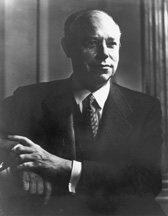
Senator Robert A. Taft
Co-sponsor of the Taft-Hartley Act.
NLRA’s Purpose
- To promote the full flow of commerce, to prescribe the legitimate rights of both employees and employers in their relations affecting commerce.
- To provide orderly and peaceful procedures for preventing the interference by either with the legitimate rights of the other.
- To protect the rights of individual employees in their relations with labor organizations whose activities affect commerce.
- To define and proscribe practices on the part of labor and management which affect commerce and are inimical to the general welfare
- To protect the rights of the public in connection with labor disputes affecting commerce
Taft-Hartley Amendment’s Impact
The amendments enacted in Taft-Hartley added a list of prohibited actions, or unfair labor practices, on the part of unions to the NLRA, which had previously only prohibited unfair labor practices committed by employers. The Taft–Hartley Act prohibited jurisdictional strikes, wildcat strikes, solidarity or political strikes, secondary boycotts, secondary and mass picketing, closed shops, and monetary donations by unions to federal political campaigns. It also required union officers to sign non-communist affidavits with the government. Union shops were heavily restricted, and states were allowed to pass right-to-work laws that outlawed closed union shops. Furthermore, the executive branch of the Federal government could obtain legal strikebreaking injunctions if an impending or current strike imperiled the national health or safety, a test that has been interpreted broadly by the courts.
Opposition to the Act
President Harry Truman vetoed Taft-Hartley, but Congress overrode his veto. Majorities of both parties voted for the bill as well as the override. Union leaders in the Congress of Industrial Organizations (CIO) vigorously campaigned for Truman in the 1948 election based upon a (never fulfilled) promise to repeal Taft-Hartley. Organized labor nearly succeeded in pushing Congress to amend the law to increase the protections for strikers and targets of employer retaliation during the Carter and Clinton administrations, but failed on both occasions because of Republican opposition and lukewarm support for these changes from the Democratic president in office at the time.
13.2.5: Landrum-Griffin Act
The Landrum-Griffin Act of 1959 is a U.S. labor law regulating labor unions’ internal affairs and officials’ relationships with employers.
Learning Objective
Explain how the Landrum-Griffin Act affected labor unions in the US
Key Points
- During the middle and late 1950s, the labor movement was under intense Congressional scrutiny for corruption, racketeering, and other misconduct.
- Some important provisions of the Act are as follows: unions have to hold secret elections, reviewable by the Department of Labor; union members are protected against abuses by a bill of rights; and unions must submit annual financial reports to the Department of Labor.
- While intended largely to limit union corruption and create a more equitable power structure within the unions, the Act was not without flaws in this regard.
- Ultimately, the act’s technical failures were exploited by both the courts and union officials—most famously the Teamsters, whose president, Jimmy Hoffa, among others, notably raided the union pension coffers for his own personal investments.
Key Terms
- Senator Griffin
-
Robert Paul Griffin (born November 6, 1923) was a U.S. Representative, U.S. Senator from the state of Michigan and Justice of the Michigan Supreme Court.
- Teamsters Union
-
The International Brotherhood of Teamsters (IBT) is a labor union in the United States and Canada. Formed in 1903 by the merger of several local and regional locals of teamsters, the union now represents a diverse membership of blue-collar and professional workers in both the public and private sectors.
- Department of Labor
-
The United States Department of Labor (DOL) is a Cabinet department of the United States government responsible for occupational safety, wage and hour standards, unemployment insurance benefits, re-employment services, and some economic statistics; many U.S. states also have such departments.
The Landrum-Griffin Act
The Labor Management Reporting and Disclosure Act of 1959 (also “LMRDA” of the “Landrum-Griffin Act”), is a United States labor law that regulates labor unions’ internal affairs and their officials’ relationships with employers. It was sponsored by Democrat Phil Landrum and Republican Robert P. Griffin.
History and Background
After passage of the Taft-Hartley Act, the number of union victories in NLRB-conducted elections declined. During the 12-year administration of the Wagner Act, unions won victories in over 80 percent of elections. But in that first year after passage of the Taft-Hartley Act, unions only won around 70 percent of the representation elections conducted by the agency.
During the middle and late 1950s, the labor movement was under intense Congressional scrutiny for corruption, racketeering, and other misconduct. Enacted in 1959 after revelations of corruption and undemocratic practices in the International Brotherhood of Teamsters, International Longshoremen’s Association, United Mine Workers and other unions received wide public attention, the Act required unions to hold secret elections for local union offices on a regular basis, and provided for review by the United States Department of Labor of union members’ claims of improper election activity. Organized labor opposed the act because it strengthened the Taft-Hartley Act of 1947.
Provisions
Important provisions of the law were as follows:
- Unions had to hold secret elections, reviewable by the Department of Labor.
- Union members are protected against abuses by a bill of rights that includes guarantees of freedom of speech and periodic secret elections of officers.
- Bar members of the Communist Party and convicted felons from holding union office.
- Require unions to submit annual financial reports to the DOL.
- Declare that every union officer must act as a fiduciary in handling the assets and conducting the affairs of the union.
- Limit the power of unions to put subordinate bodies in trusteeship, a temporary suspension of democratic processes within a union.
- Provide certain minimum standards before a union may expel or take other disciplinary action against a member of the union.
Amendment to the National Labor Relations Act
Congress also amended the National Labor Relations Act, as part of the same piece of legislation that created the LMRDA, by tightening the Taft-Hartley Act’s prohibitions against secondary boycotts, prohibiting certain types of “hot cargo” agreements, under which an employer agreed to cease doing business with other employers, and empowering the General Counsel of the National Labor Relations Board to seek an injunction against a union that engages in recognitional picketing of an employer for more than thirty days without filing a petition for representation with the NLRB.
Consequences and Results
While intended largely to limit union corruption and create a more equitable power structure within the unions, the Act was not without flaws in this regard. Twenty years after the passage of the Act, co-sponsor Senator Robert Griffin extolled its success in writing, saying: “Today, nearly two decades after enactment, it is undeniable that the Landrum-Griffin Act has played a significant role in enabling union members to participate more freely in the affairs of their unions. On the other hand, it cannot be said that union corruption and abuses of union power have disappeared. But such conduct in the union movement is not as common as it was twenty years ago; and, in large measure, that can be credited to the existence of the Landrum-Griffin Act. ” Senator Griffin acknowledged the shortcomings, particularly with regard to the Teamsters. However, Griffin argued that these violations were contrary to the Act, placing the blame instead on the Department of Labor for failing to pursue action against the Teamsters union for its corruptions.
Ultimately, the act’s technical failures were exploited by both the courts and union officials—most famously the Teamsters, whose president, Jimmy Hoffa, among others, notably raided the union pension coffers for his own personal investments. While the Act ostensibly was created to foster democracy, the judiciary frequently interpreted it in ways to minimize internal union dissonance and labor disruption, favoring instead the stern hand of management. As law professor Alan Hyde put it: “Indeed, the courts advance democratic bargaining only when assured that such democracy will not disadvantage more fundamental policy interests, such as harmony between employers and “unions” (read union elites) or control of inflation. “
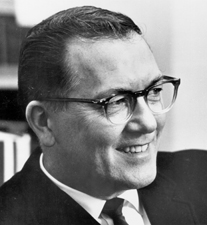
Republican Senator Robert P. Griffin
Co-sponsor of the Landrum-Griffin Act.
13.3: Collective Bargaining
13.3.1: A Brief Definition
Through collective bargaining, employers and employees negotiate the conditions of employment.
Learning Objective
Define the monopoly union model, the right-to-manage model, and the efficient bargaining model as theories of collective bargaining
Key Points
- The ability to form trade unions is recognized through international human rights conventions as an essential right of workers.
- Trade union representatives usually represent the employees during the collective bargaining process. The union representatives negotiate with a single employer or a group of businesses. Negotiations with a group of businesses results in an industry-wide agreement.
- There are various economic theories which attempt to explain the various aspects of collective bargaining.
- The agreement reached as a result of the collective bargaining process functions as a contract between the parties.
Key Terms
- efficient bargaining model
-
The efficient bargaining model sees the union and the firm bargaining over both wages and employment (or, more realistically, hours of work).
- collective bargaining agreement
-
A collective agreement or collective bargaining agreement (CBA) is an agreement between employers and employees which regulates the terms and conditions of employees in their workplace, their duties, and the duties of the employer. It is usually the result of a process of collective bargaining between an employer (or a number of employers) and a trade union representing workers.
- monopoly union model
-
This model states that the monopoly union has the power to maximize the wage rate; the firm then chooses the level of employment.
Example
- Factory workers may unionize and use collective bargaining to determine a wage rate that is mutually beneficial to the workers and the employers.
Collective Bargaining Defined
Collective bargaining is a process of negotiation between employers and a group of employees aimed at reaching an agreement that regulates working conditions .

Collective Bargaining
Map of proposed collective bargaining legislation
The right to collectively bargain is recognized through international human rights conventions. Article 23 of the Universal Declaration of Human Rights identifies the ability to organize trade unions as a fundamental human right. Item 2(a) of the International Labour Organization’s Declaration on Fundamental Principles and Rights at Work defines the “freedom of association and the effective recognition of the right to collective bargaining” as an essential right of workers.
The Participants
The interests of the employees are commonly presented by representatives of a trade union to which the employees belong. The union may negotiate with a single employer (who is typically representing a company’s shareholders) or may negotiate with a group of businesses, depending on the country, to reach an industry-wide agreement.
The Result
The parties often refer to the result of the negotiation as a collective bargaining agreement (CBA) or as a collective employment agreement (CEA). A collective agreement functions as a labor contract between an employer and one or more unions.
The collective agreements reached by these negotiations usually set out wage scales, working hours, training, health and safety, overtime, grievance mechanisms, and rights to participate in workplace or company affairs.
Collective Bargaining Models
Different economic theories provide a number of models intended to explain some aspects of collective bargaining:
- The so-called monopoly union model (Dunlop, 1944) states that the monopoly union has the power to maximize the wage rate; the firm then chooses the level of employment.
- The right-to-manage model, developed by the British school during the 1980s (Nickell), views the labor union and the firm bargaining over the wage rate according to a typical Nash Bargaining Maximin.
- The efficient bargaining model (McDonald and Solow, 1981) sees the union and the firm bargaining over both wages and employment (or, more realistically, hours of work).
13.3.2: Resolving Disagreements
Labor arbitration has been used as an alternative to strikes to resolve labor disputes for more than a century.
Learning Objective
Distinguish between interest arbitration and grievance arbitration
Key Points
- There are two types of labor arbitration: interest arbitration and grievance arbitration.
- Governments, in addition to labor organizations, rely on arbitration to resolve particularly large labor disputes.
- Unions and employers have used arbitration to resolve employee and union grievances arising under a collective bargaining agreement.
- The Supreme Court has held that grievance arbitration is a preferred dispute resolution technique and that courts cannot overturn arbitrators’ awards, unless the award does not draw its essence from the collective bargaining agreement.
Key Terms
- arbitration
-
In general, a form of justice where both parties designate a person whose ruling they will accept formally. More specifically in Market Anarchist (market anarchy) theory, arbitration designates the process by which two agencies pre-negotiate a set of common rules in anticipation of cases where a customer from each agency is involved in a dispute.
- grievance arbitration
-
Provides a method for resolving disputes over the interpretation and application of a collective bargaining agreement.
- interest arbitration
-
Provides a method for resolving disputes about the terms to be included in a new contract when the parties are unable to agree.
Examples
- The Coal Strike of 1902 was a strike by the United Mine Workers of America in the anthracite coal fields of eastern Pennsylvania. The strikers were asking for higher wages, shorter workdays, and the recognition of their union. The strike threatened to shut down the winter fuel supply to all major cities. President Theodore Roosevelt became involved and set up a fact-finding commission that suspended the strike. The strike never resumed, as the miners received more pay for fewer hours; the owners got a higher price for coal, and did not recognize the trade union as a bargaining agent. It was the first labor episode in which the federal government intervened as a neutral arbitrator.
- The United Steelworkers of America adopted an elaborate form of interest arbitration, known as the Experimental Negotiating Agreement, in the 1970s as a means of avoiding the long and costly strikes that had made the industry vulnerable to foreign competition.
- Major League Baseball uses a variant of interest arbitration, in which an arbitrator chooses between the two sides’ final offers, to set the terms for contracts for players who are not eligible for free agency. Interest arbitration is now most frequently used by public employees who have no right to strike (for example,, law enforcement and firefighters).
Labor Arbitration
Arbitration has been used as a means of resolving labor disputes for more than a century. Labor organizations in the United States, such as the National Labor Union, called for arbitration as early as 1866 as an alternative to strikes to resolve disputes over the wages, benefits and other rights that workers enjoy. Governments have also relied on arbitration to resolve particularly large labor disputes, such as the Coal Strike of 1902.
Types of Labor Arbitration
Labor arbitration comes in two varieties: interest arbitration, which provides a method for resolving disputes about the terms to be included in a new contract when the parties are unable to agree, and grievance arbitration, which provides a method for resolving disputes over the interpretation and application of a collective bargaining agreement.
Interest Arbitration
This type of arbitration, wherein a neutral arbitrator decides the terms of the collective bargaining agreement, is commonly known as interest arbitration. The United Steelworkers of America adopted an elaborate form of interest arbitration, known as the Experimental Negotiating Agreement, in the 1970s as a means of avoiding the long and costly strikes that had made the industry vulnerable to foreign competition.
Major League Baseball uses a variant of interest arbitration, in which an arbitrator chooses between the two sides’ final offers, to set the terms for contracts for players who are not eligible for free agency. Interest arbitration is now most frequently used by public employees who have no right to strike (for example, law enforcement and firefighters).
Grievance Arbitration
Unions and employers have also employed arbitration to resolve employee and union grievances arising under a collective bargaining agreement. The Amalgamated Clothing Workers of America made arbitration a central element of the Protocol of Peace it negotiated with garment manufacturers in the second decade of the twentieth century. Grievance arbitration became even more popular during World War II, when most unions had adopted a no-strike pledge.
Arbitration in the Eyes of the Law
The Supreme Court subsequently made labor arbitration a key aspect of federal labor policy in three cases which came to be known as the Steelworkers’ Trilogy. The Court held that grievance arbitration was a preferred dispute resolution technique and that courts could not overturn arbitrators’ awards unless the award does not draw its essence from the collective bargaining agreement.
These protections for arbitrator awards are premised on the union-management system, which provides both parties with due process. Due process in this context means that both parties have experienced representation throughout the process, and that the arbitrators practice only as neutrals.
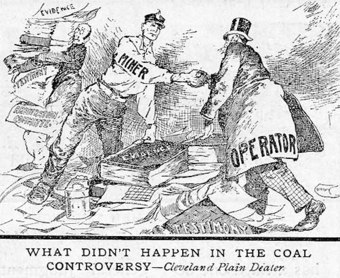
Political Cartoon about the Anthracite Coal Strike
The two sides were supposed to listen to expert testimony and come to a friendly agreement; cartoon from the Cleveland Dealer
13.4: Managing Employees
13.4.1: Pay
By considering internal and external equity, a company can work toward a fair base pay system, attracting and retaining the best employees.
Learning Objective
Combine internal equity and external equity analysis to determine fair pay
Key Points
- Companies decide the pay associated with each job by analyzing the content of each job, assessing the value each job contributes to the company, pricing each job in the market, and looking at the relationship between what they value internally and what the market values externally.
- A base pay system needs to be internally equitable; the amount of base pay assigned to jobs needs to reflect the relative contribution of each job to the company’s business objectives.
- Job analysis is a systematic method to discover and describe the differences and similarities among jobs. Job evaluation is a process that takes the information gathered by the job analysis and places a value on the job.
- “External equity” refers to the relationship between one company’s pay levels in comparison to what other employers pay. Market definition is important to measuring external equity.
- Market definition is important to measuring external equity.
Key Terms
- job evaluation
-
Job evaluation is a systematic way of determining the value or worth of a job in relation to other jobs in an organisation. It tries to make a systematic comparison between jobs to assess their relative worth for the purpose of establishing a rational pay structure.
- internal equity
-
Internal equity is the idea of compensating employees in similar jobs in a similar way
- job analysis
-
Job analysis is the formal process of identifying the content of a job in terms of activities involved and attributes needed to perform the work.
Example
- Imagine that see a job posted on the internet. It reads, “Office Assistant wanted, starting at $8.00 an hour.” How did the manager decide to pay $8.00 per hour? Why did he or she decide that was fair? The manager looks at the internal and external equity to determine that $8.00 an hour is a fair base pay for workers.
Is the Pay Fair?
Imagine that see a job posted on the internet. It reads, “Office Assistant wanted, starting at $8.00 an hour.” How did the manager decide to pay $8.00 per hour? Why did he or she decide that was fair? In this subchapter, we will cover the two types of “fairness” important in designing a base pay system.
Internal Equity
The first consideration is that the base pay system needs to be internally equitable: the amount of base pay assigned to jobs needs to reflect the relative contribution of each job to the company’s business objectives . In determining this, the manager should ask, “How does the work of the office assistant described above compare with the work of the office manager?” Another question to be asked is, “Does this worker contribute to solutions for customers more than another?”
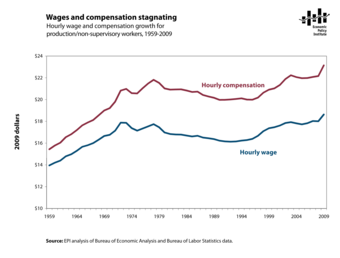
Hourly wage and compensation growth for production/non-supervisory workers, 1959-2009
This graph shows that compensation and wages have been more or less stagnant since the 1970’s.
Internal equity implies that pay rates should be the same for jobs where the work is similar and different for jobs where the work is dissimilar. Compensation specialists use two tools to help make these decisions: job analysis and job evaluation.
What is Job Analysis?
A job analysis is a systematic method to discover and describe the differences and similarities among jobs. A good job analysis collects sufficient information to adequately identify, define, and describe the content of a job. Since job titles may be misleading (for example, “systems analyst” does not reveal much about the job) the content of the job is more important to the analysis than the title.
In general, a typical job analysis attempts to describe the following:
- skill (the experience, training, education, and ability required by the job);
- effort (the degree of effort actually expended in performing the job);
- responsibility (the degree of accountability required in the performance of a job); and
- working conditions of each job (the physical surroundings and hazards of a job, including dimensions such as inside versus outside work, heat, cold, and poor ventilation).
What is a Job Evaluation?
A job evaluation is a process that takes the information gathered by the job analysis and places a value on the job. It is the process of systematically determining the relative worth of jobs based on a judgment of each job’s value to the organization. The most commonly used method of job evaluation in the United States and Europe is the “point method.” The point method consists of three steps:
- defining a set of compensable factors;
- creating a numerical scale for each compensable factor; and
- weighting each compensable factor.
Each job’s relative value is determined by the total points assigned to it . The result of the job analysis and job evaluation processes will be a pay structure or queue in which jobs are ordered by their value to the organization.
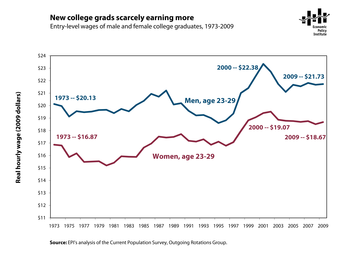
Entry Level Wages for College Graduates, 1973-2009
New college graduates are scarely earning more than they did a few decades ago.
External Equity
“External equity” refers to the relationship between one company’s pay levels in comparison to what other employers pay. Some employers set their pay levels higher than their competition, hoping to attract the best applicants. This is called “leading the market.”
Other employers set their pay levels lower than their competition, hoping to save labor costs. This is called “lagging the market.” The risk in lagging the market is that the company will be unable to attract the best applicants.
Most employers set their pay levels the same as their competition. This is called “matching the market.” Matching the market maximizes the quality of talent while minimizing labor costs. An important question in external equity is how you define your market. Traditionally, markets can be defined in one of three ways:
- By identifying companies who hire employees with the same occupations or skills
- By identifying companies who operate in the same geographic area
- By identifying direct competitors, that is, those companies who produce the same products and services.
Once you have defined your market, the next step is to survey the compensation paid by employers in your market.
Combining Internal and External Equity
How do companies combine internal and external equity to decide the pay associated with each job?
- First, they analyze the content of each job.
- Second, they assess the value each job contributes to the company.
- Third, they price each job in the market.
- Finally, they look at the relationship between what they value internally and what the market values externally.
By following each of these steps, a company will have a fair base pay system, which will lead to attracting and retaining the best employees.
13.4.2: Scheduling Work
Job design is the allocation of specific work tasks to individuals and groups, in line with the company’s general direction and strategy.
Learning Objective
Explain the evolution of job design theory
Key Points
- A task can be best defined as a piece of assigned work expected to be done within a certain time. Motivation describes forces within the individual that account for the level, direction, and persistence of effort expended at work.
- Traditional approaches to job design include Taylorism, Hertzberg’s Motivation-Hygiene Theory, and goal-setting theory.
- Contemporary approaches include the socio-technical systems (STS) approach, and the Job Characteristics Model (JCM).
- The key to effectively crafting a meaningful job for an employee is starting the thought process by looking at the values and strategy of the organization.
- The “Socio-Technical Systems” (STS) approach of job design states that the design of the organization must fit its goals, employees must be actively involved in designing the structure of the organization, support systems must fit in with the design of the organization, et al. The “Job Characteristics Model” (JCM) maintains five important elements that motivate workers and performance: The “Psychological Empowerment Theory” posits that when a person is aware of the impact that they are having, they benefit more than if they cannot relate a positive impact to any of their behaviors or practices.
- The key to effectively crafting a meaningful job for an employee is starting the thought process by looking at the values and strategy of the organization.
Key Terms
- resource Allocation
-
Resource allocation is used to assign the available resources in an economic way. It is part of resource management. In project management, resource allocation is the scheduling of activities and the resources required by those activities while taking into consideration both the resource availability and the project time.
- Taylorism
-
scientific management; a theory of management of the early 20th century that analyzed workflows in order to improve efficiency
Example
- Intrapreneurship is an example of motivation through job design, either formally or informally. Many companies are famous for setting up internal organizations whose purpose is to promote innovation within their ranks. (1) One of the most well-known is the Skunk Works group at Lockheed Martin. The group was originally named after a reference in a cartoon and was first brought together in 1943 to build the P-80 fighter jet. Because the project was to eventually become a part of the war effort, the project was internally protected and secretive. Kelly Johnson, later famous for Kelly’s 14 rules of intrapreneurship, was the director of this group. (2) Another example could be 3M, who encourage many projects within the company. They give certain freedom to employees to create their own projects, and they even give them funds to use for these projects. (In the days of its founders, HP used to have similar policies and just such an innovation-friendly atmosphere and intrapreneurial reputation. ) (3) Besides 3M, Intel also has a tradition of implementing intrapreneurship. (4) Google is also known to be intrapreneur friendly, allowing their employees to spend up to 20% of their time to pursue projects of their choice.
Scheduling Work
Introduction
Job design is defined as the allocation of specific work tasks to individuals and groups (Schermerhorn, Job Design Alternatives, 2006). Allocating jobs and tasks means specifying the contents, methods and relationships of jobs to satisfy technological and organizational requirements as well as the personal needs of jobholders. If successful job design is not implemented, than the companies general strategy and direction will be strongly diverted. Meaningful jobs must also exemplify the company’s goals and culture.
Elements to Job Design
In order to better understand job design it is helpful to define some key elements and their relationship with job design processes.
A task is a piece of assigned work expected to be done within a certain time. It is important to strictly and thoroughly identify tasks that need completion. In addition, it is essential to design jobs that motivate employees. Motivation describes forces within the individual that account for the level, direction, and persistence of effort expended at work (Schermerhorn). In job design, it is necessary to identify and structure jobs in a way that the company’s resources are being efficiently used. Resource Allocation occurs when organizations decide to appropriate or allocate certain resources to specific jobs, tasks or dilemmas facing the organization.
Jobs need to be constructed so that efficiency of the worker or department is maximized. Organizations need to use the resources and creativity of their employees effectively and efficiently. Reward systems also play a role in job design. Reward systems include compensation, bonuses, raises, job security, benefits, and various other methods of reward for employees.
Traditional Approaches to Job Design
Frederick Taylor developed a theory in an effort to establish a science for every job within an organization (Taylorism or Scientific Management) . The principles of Taylorism are as follows:
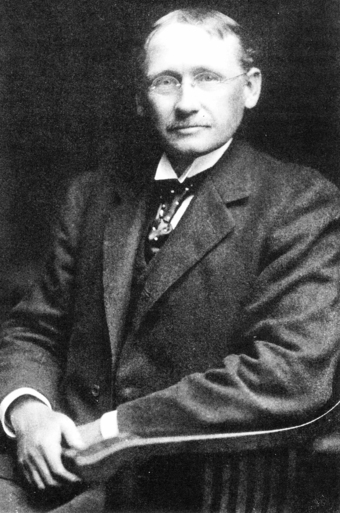
Frederick Taylor
Frederick Winslow Taylor lived from 1856 to 1915. Taylorism was named after him.
- Create a standard method for each job;
- Successfully select and hire proper workers;
- Effectively train these workers;
- Support these workers.
Hertzberg’s Motivation-Hygiene Theory attempts to uncover psychological needs of employees and enhance employee satisfaction. Employers are encouraged to design jobs that enhance and motivate employees beyond simply meeting a daily or weekly quota. This theory highlights the importance of rewards systems and monitoring when and how employees are rewarded.
Edwin Locke’s Goal Setting Theory mainly focuses on the motivational properties of task goals (Schermerhorn). Task goals can be highly motivating when set and managed properly. One of the problems with a goal setting theory in job design is that individuals are more strongly motivated by establishing or setting their own personal goals. If organizations set these goals for their employees, then the effectiveness of this technique is diminished.
Current Approaches to Job Design
Technology and the flattening of the global economy have contributed greatly to the changes we now see in jobs and job content across the world. We now recognize that a person presented with quality meaningful work is more likely to do that work well. Because of this insight, job design presently takes some prominent forms.
The first of which is designed around the evolution from individual work to work-groups. This job design practice is called “socio-technical systems” (STS) approach. This approach has the following guiding principles:
- The design of the organization must fit its goals.
- Employees must be actively involved in designing the structure of the organization.
- Control of variances in production or service must be undertaken as close to their source as possible.
- Subsystems must be designed around relatively self-contained and recognizable units of work.
- Support systems must fit in with the design of the organization.
- The design should allow for a high quality of working life.
Another modern job design theory is the Job Characteristics Model (JCM), which maintains five important elements that motivate workers and performance:
- Skill variety,
- Task identity,
- Task significance,
- Autonomy,
- Job feedback.
The individual elements are then proposed, which lead to positive outcomes through three psychological states: experienced meaningfulness, experienced responsibility, and the knowledge of results (Parker & Turner, 2002).
Steps to Effective Job Design
The key to effectively crafting a meaningful job for an employee is starting the thought process by looking at the values and strategy of the organization. By framing the job in these contexts, the job design process is more likely to align potential employees with the purpose of the company. Once you have this context, the following steps will ensure both meaningful and effective job design:
- Assess skills, needs, abilities, and motivations of employees and the organization.
- Design the job to meet those needs, abilities and motivations.
- Implement the new job design.
- Audit the success of the job design and begin with step one periodically as well as when problems have been identified.
13.4.3: Executive Compensation
Levels of executive pay have been controversial in recent times, with only tenuous links between executive pay and company performance.
Learning Objective
Analyze the arguments for and against huge growth in executive compensation
Key Points
- When looking at the long-term prospects of the company, a good CEO will assemble and maintain a top-notch management team and nurture leaders to take over.
- Executive pay is financial compensation received by an officer of a firm. It is typically a mixture of salary, bonuses, shares of and call options on the company stock, benefits, and perquisites.
- Excessive executive compensation has been criticized from all quarters, but defenders say that it is because of the competition that exists between companies for a limited number of top executives.
Key Term
- chief executive officer
-
The highest-ranking corporate officer or executive officer of a corporation, company, or agency, responsible for carrying out the policies of the board of directors on a day-to-day basis; CEO.
Example
- The ratio of CEO pay to average worker pay is far greater in the U.S. compared with other countries. In Japan, the ratio of CEO pay to average worker pay is 11:1; in Italy, it is 20:1; in Britain, it is 22:1; in Mexico, it is 47:1; and in the U.S., the ratio is 475:1.
A Top-notch Team is Needed for Corporate Success
Typically, the chief executive officer (CEO) directs the fortunes of the company. It helps that the CEO has a good team that includes the chief operating officer (COO) who leads the operations of a company, and chief financial officer (CFO) who manages the finances. Also important in different companies are the chief marketing officer (CMO) and the chief information officer (CIO), who manages the information systems. When looking at the long-term prospects of the company, a good CEO will assemble and maintain a top-notch management team and nurture leaders to take over.
Controversy Over Executive Compensation
Executive pay (also known as executive compensation) is financial compensation received by an officer of a firm. It is typically a mixture of salary, bonuses, shares of and call options on the company stock, benefits, and perquisites, ideally configured to take into account government regulations, tax law, the desires of the organization and the executive, and rewards for performance.
Many policy makers are concerned about the huge growth in executive compensation and the lack of a relationship between performance and compensation. An example from the recent financial crisis are the CEOs who led their companies into insolvency and bankruptcy yet were still given huge pay packages .
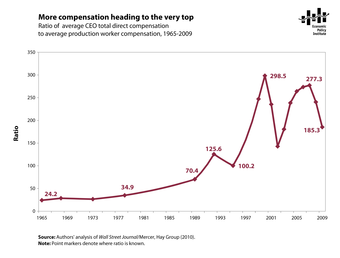
More Compensation Heading to the Very Top
During the financial crisis of 2008, many CEOs led their companies into insolvency and bankruptcy yet were still given huge pay packages.
In general, the compensation of CEOs in the United States has risen to over 400 times the salary of the average U.S. worker, compared to about 30 times only a few decades ago . This is different from other countries where the disparity is not so great.
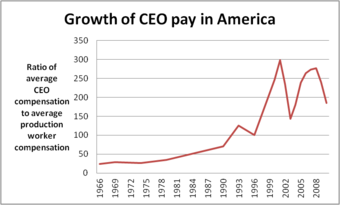
Growth of CEO Pay In America
The compensation of CEOs in the United States has risen to over 400 times the salary of the average U.S. worker, compared to about 30 times only a few decades ago.
The explosion in executive pay has become controversial, criticized by not only leftists but conservative establishmentarians such as Ben Bernanke, Peter Drucker, John Bogle, and Warren Buffet. The idea that stock options and other alleged pay-for-performance are driven by economics has also been questioned. A 2001 article in Fortune, “The Great CEO Pay Heist” drew criticism for this line of thinking: instead of arguing that “the stock isn’t moving, so the CEO shouldn’t be rewarded”, it instead argued that “the stock isn’t moving, so we’ve got to find some other basis for rewarding the CEO. ” This line of thinking is exactly why executive compensation has come under so much criticism.
Defenders of high executive pay say that the global war for talent and the rise of private equity firms can explain much of the increase in executive pay. For example, while in conservative Japan a senior executive has few alternatives to his current employer, in the United States it is acceptable and even admirable for a senior executive to jump to a competitor, to a private equity firm, or to a private equity portfolio company. Portfolio company executives take a pay cut but are routinely granted stock options for ownership of 10% of the portfolio company, contingent on a successful tenure. Rather than signaling a conspiracy, defenders argue, the increase in executive pay is a mere byproduct of supply and demand for executive talent. However, U.S. executives make substantially more than their European and Asian counterparts.
As of 20120, the current ratio of CEO pay to average worker pay was:
- Japan 11
- Germany 12
- France 15
- Italy 20
- Canada 20
- South Africa 21
- Britain 22
- Hong Kong 41
- Mexico 47
- Venezuela 50
- United States 475
13.4.4: Sexual Harrassment
Sexual harassment is bullying or coercion of a sexual nature, or unwelcome/inappropriate promises of rewards in exchange for sexual favors.
Learning Objective
Explain the effects of sexual harassment and how organizational policies can prevent it from occuring
Key Points
- Harassment can include unwelcome sexual advances, requests for sexual favors, and other verbal or physical harassment of a sexual nature. It includes a range of behavior from mild transgressions to sexual abuse or sexual assault.
- In the workplace, harassment may be considered illegal when it is so frequent or severe that it creates a hostile or offensive work environment, or when it results in an adverse employment decision.
- Psychologists and social workers report that severe or chronic sexual harassment can have the same psychological effects as rape or sexual assault.
- Studies show that the organizational climate (an organization’s tolerance, policy, procedure etc.) and workplace environment are essential for understanding the conditions in which sexual harassment is likely to occur, and the way its victims will be affected.
Key Terms
- sexual harassment
-
bullying or coercion of a sexual nature, or the unwelcome or inappropriate promise of rewards in exchange for sexual favors.
- retaliation
-
a sometimes violent response to an act of harm or perceived injustice.
Example
- Academic studies have carefully shown how cultural differences affect attitudes about sex, sexual advances, and hostility at work. In one study, American, Australian, and German collegians were offered written scenarios of sexual overtures in offices. Responses from all three nationalities were similar, but as a group, they were far more likely to brand the episodes with terms like harassment than were their peers from Brazil. Faced with the same scenarios, the Brazilians tended to see only innocuous pokes at romance and sex that didn’t constitute abuse of power or create a hostile environment. A similar experiment showed a comparable split between typical adults living in the United States (more prone to see harassment) and Ecuador (more likely to see scenarios as flirtatious or harmless sexual jousting).
Sexual Harassment Defined
Sexual harassment is bullying or coercion of a sexual nature, or the unwelcome or inappropriate promise of rewards in exchange for sexual favors. Harassment can include unwelcome sexual advances, requests for sexual favors, and other verbal or physical harassment of a sexual nature. Sexual harassment can includes a range of behavior from mild transgressions (like jokes or innuendos) to sexual abuse or sexual assault, but laws against sexual harassment typically don’t prohibit simple teasing, offhand comments, or minor isolated incidents. In the workplace, harassment may be considered illegal when it is so frequent or severe that it creates a hostile or offensive work environment, or when it results in an adverse employment decision (such as the victim being fired or demoted, or when the victim decides to quit the job). Sexual harassment may occur in a variety of circumstances. Often, but not always, the harasser is in a position of power or authority over the victim (due to differences in age, level of employment, or years with the company). For many businesses and other organizations, preventing sexual harassment—and addressing any incidents of it— has become a major priority within their ranks.
Effect on Victims
Effects of sexual harassment can vary depending on the individual victim and the severity and duration of the harassment. Psychologists and social workers report that severe or chronic sexual harassment can have the same psychological effects as rape or sexual assault. Victims who do not submit to harassment may also experience other forms of harassment including retaliation in the form of isolation or bullying. Common psychological effects of sexual harassment and retaliation that could affect your academic, professional, financial or social life include:
- Decreased work or school performance as a result of stress conditions, including increased absenteeism in fear of repeated harassment;
- Fear of being fired or refused a promotion or job opportunity; loss of job or career, and loss of income;
- Having one’s personal life offered up for public scrutiny—the victim becomes the “accused,” and his or her person, appearance, lifestyle, and private life can often come under attack;
- Becoming publicly sexualized (i.e. groups of people “evaluate” the victim to establish if he or she is “worth” the sexual attention or the risk to the harasser’s career);
- Defamation of character and reputation;
- Loss of trust in environments similar to where the harassment occurred;
- Loss of trust in the types of people that occupy similar positions as the harasser or his or her colleagues; difficulties or stress with peer relationships, or relationships with colleagues;
- Extreme stress on relationships with significant others, including personal sexual life, sometimes resulting in divorce;
- Weakening of support network, or being ostracized from professional or academic circles (friends, colleagues, or family may distance themselves from the victim, or shun him or her altogether);
- Having to relocate to another city, another job, or another school.
Organizational Policies and Procedures
When organizations do not take the satisfactory measures for properly investigating sexual harassment, do not offer psychological counseling and guidance, or just decide to ignore the problem or not take it seriously, this could lead to:
- Decreased productivity and increased team conflict;
- Decreased study or job satisfaction;
- Loss of students or staff;
- Resignations of alleged harassers;
- Increased absenteeism by staff or students experiencing harassment;
- Decrease in success at meeting academic or financial goals;
- Increased health care costs and sick pay costs because of the health consequences of harassment and/or retaliation;
- High jury awards for the victim of the harassment;
If the problem is ignored or not treated properly, a company’s or school’s image can suffer. Moreover, the knowledge that harassment is permitted can undermine the ethical standards of the organization in general, as staff and/or students lose respect for, and trust in, their superiors or supervisors who indulge in, turn a blind eye to, or handle incidents of sexual harassment improperly.
Studies show that the organizational climate (an organization’s tolerance, policies, procedures, etc.) and workplace environment are essential for understanding the conditions in which sexual harassment is likely to occur, and the way its victims will be affected. According to Dr. Orit Kamir, the most effective way to avoid sexual harassment in the workplace, and also influence the public’s state of mind, is for the employer to adopt a clear policy prohibiting sexual harassment and to make it very clear to his or her employees.
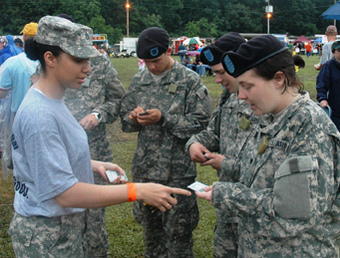
Sexual Harassment In the Military
Historically, sexual harassment has been prevalent in the military. Pictured here are members of I.A.M. Strong, the Army’s campaign to combat sexual harassment and sexual assaults.
13.4.5: Childcare
Empowering a strong work/life balance for employees increases loyalty and job satisfaction while building a strong family-oriented culture.
Learning Objective
Understand the value of various parental benefits from the organizational perspective
Key Points
- Benefits that empower employees to establish a strong work/life balance can provide significant organizational benefits.
- New parents need more support than most, and integrating chlid care programs, maternity/paternity leave, and emergency leave is absolutely critical to building a strong and more focused workforce.
- There are various ways to approach child care, but most smaller to medium sized organizations will outsource this to local professionals. Keep in mind, different childcare centers specialize in different age groups.
- Providing child care benefits increases employee loyalty and focus, decreases anxiety, and reduces absenteeism while building a strong, family-oriented organizational culture.
Key Terms
- childcare
-
The act or practice of taking care of children.
- absenteeism
-
The practice of missing days of work.
Providing benefits such as childcare, maternity/paternity leave, flexible working, and emergency leave is critical for helping employees keep a healthy work/life balance. The responsibilities of parenting require a great deal of time and energy, and supporting new parents as they find time for everything can significantly improve employee satisfaction, retaining key talent through good benefits and employee support.
How To Support Parents
Childcare
The scope of a child care program is up to the business itself, as well as the decision to create this benefit in house or to outsource it. Most commonly, businesses will create agreements with childcare providers in the local area, covering or sharing the costs of childcare while the parents are at work. However, not all programs will fit all age groups. Larger organizations may want to consider partnerships for the following:
- Infant care (0-1 year old)
- Corporate child center (0-3 years old)
- Corporate kindergarten (3-6 years old)
- Corporate camp for holidays (3-14 years old)
Through providing childcare benefits, employers can potentially realize the following benefits:
- Reduced employee absenteeism
- Increased focus at work
- Decreased healthcare costs
- Development of a strong, family-oriented culture
- Increased employee loyalty
- Reduced HR costs (recruiting/onboarding new employees)
Other Parental Support Programs
New parents need more than childcare to fully balance work and life demands. Providing ample time for maternal and paternal leave is critical to empowering employees to adjust to their new responsibilities. Parents need time to organize their new lives, and create a strong ecosystem for their family to thrive.
Along similar lines, emergency leave is also absolutely necessary in case something happens. Employees who are afraid of getting in trouble for having to leave work early will be less loyal, less focused and more anxious about the demands of their home and work lives. Trusting employees to get the job done when and how they can, and providing a flexible and family-oriented work culture, is an incredible advantage.

Daycare
This image shows children at a daycare, where employee children can socialize and learn while the parents are at work.
13.4.6: Drug Screening
Explaining why drug testing is necessary and following proven process guidelines will go a long way toward appeasing workers.
Learning Objective
Explain the common practice of firms’ drug testing
Key Points
- While most employees feel the purpose of drug screening is to identify people doing something illegal off duty and then punish them, the real point is to prevent impaired workers from hurting themselves or others.
- There are two kinds of employment drug testing: pre-employment drug screening and publish-employment drug testing.
- There are legal issues relating to drug testing that must be adhered to. For instance, the Fourth Amendment ensures protection against unreasonable search and seizure, and drug testing can be argued to fall under this.
- There are issues regarding the legality of drug testing.
Key Term
- drug test
-
Any chemical check for the presence of (usually illegal) drugs in a sample of one’s blood, hair, or urine.
Example
- In Maryland, drug testing laws make it possible to screen for drugs using a hair specimen for pre-employment purposes only.
Drug Screening
When employees discuss the subject of examinations for illegal or illicit chemical use, there is almost always a negative tone to the discourse. No person really likes the idea that he or she is in any way suspected of such activity. As an unfortunate consequence of our societal behavior, however, a company requiring a drug test is reasonable, and can be done without rancor.
As with almost any managerial policy, the more the workforce understands about why it was created and what it entails, the less resistance there will likely be.
The Purpose of Drug Testing
There are two kinds of employment drug testing: pre-employment drug screening and publish-employment drug testing.
Pre-employment testing is carried out prior to recruiting individuals to make certain that drug abusers do not enter into the business. This is done under the premise that human assets are the biggest assets of a reputed organization. Talented staff members have a positive impact on productivity. However, this productivity is jeopardized when a company’s workers use illicit drugs.
In accordance with the most recent reports (2009) released by Compound Abuse and Mental Health Expert services Administration (SAMHSA), out of 19.3 million illicit drug abusers aged 18 many years or older, 12.9 million had been employed full time or part time in United States. This knowledge signifies that many illicit drug users are finding employment and that they may well impact the organizational lifestyle.
Pre-employment drug testing can help in generating a sense of fear in people looking for work, as the odds are, if they use drugs, their application will be rejected due to them screening positive.
Comparing it with the automatic process undergone by everyone in federal service will help clarify the importance of having “clean” employees, as the idea of impaired FBI agents is clearly problematic to all. Relating that to the performance of duties at the corporate level is not a huge leap of logic.
Drug Screening and Constitutional Law
Some states do not have specific laws addressing this issue, so it is up to corporate policy to determine the best approach.
The Fourth Amendment ensures protection against unreasonable search and seizure, and these examinations have been held to be covered by this provision. One issue that comes up in the practice of conducting these processes is how much is too much. Even people who understand the rationale and grudgingly approve of it become incensed if the checks occur too often. All citizens are protected against the denial of life, liberty and the pursuit of happiness, and this has been ruled to mean excessive intrusion on person or privacy.
Making Employees Understand the Necessity of Drug Testing
One key to approaching the subject with the workforce is to address it in the venue of safety.
Most employees feel the purpose of drug screening is to identify people doing something illegal off duty and then punish them. Keeping the focus on what the real point is, which is the prevention of impaired workers from hurting themselves or others, can be key to acceptance. Many employees do not consider the ramifications to the enterprise or employer should their actions result in loss, injury, or fatality. They do not know the legal responsibility an employer has to ensure that employees are competent and ready to work.
Knowing that their mishaps could cost the employer will help employees realize why it is important that everyone be substance free on the job. Even though they understand the reasons for it, the physical process of the examination is ultimately humiliating and degrading, with some workers tolerating it better than others. Choosing a company that has a good reputation, who are willing to collect feedback from those who are examined will also ease the effort. Testing at the workplace, instead of some third-party location, is less disruptive and faster.
Nevertheless, the practice of drug testing in a company protects everyone. Remaining careful to avoid any perception of bias through uniform and fair exercise will appease workers as much as possible. Following proven process guidelines will ensure that any challenge to the program will result in a finding for the company.

Strand of Hair
A strand of hair is all it takes to tell the story of illicit drug use.
13.4.7: Violence in the Workplace
Conflict in the workplace arises when there is a non-acceptance of the differences which exist between people at work.
Learning Objective
Explain the causes of and solutions to conflict in the workplace
Key Points
- Human resource managers report spending 24% to 60% of their time dealing with employee disputes.
- Causes for conflict within the workplace may include poor organizational structures, a strong spirit of competitiveness and non-cooperation, poor communication, personality conflicts, frequent change, and lack of teamwork.
- Strategies to help resolve worker conflict may include listening carefully, staying impartial, and agreeing to work on an action plan going forward.
Key Term
- conflict
-
A clash or disagreement, often violent, between two opposing groups or individuals.
Example
- A disgruntled employee may violently act out against another employee if she feels slighted or the need to retaliate. However, due to different styles of interaction or differing values or beliefs, the cause of the conflict may just be a miscommunication.
Introduction

The Pillow Fight
Unfortunately, most employee conflicts aren’t as good-natured as this pillow fight.
Human resource managers report spending 24% to 60% of their time dealing with employee disputes.
According to a study by the Society of Human Resource Management (SHRM), the number of violent incidents in the workplace has been increasing. Nearly 60% of respondents said violence had occurred in their organization during the past three years, and they identified “personality conflicts” as the leading cause.
Why Conflicts Arise
Conflict arises when one or more person tries to ensure their preferred outcome is achieved to the exclusion of the preferred outcome of others. Causes of conflict within an organization include:
- Poor organization structures where people may feel alienated or isolated, thus the spirit of competitiveness and non-cooperation may be strong.
- Poor communication where people don’t have the opportunity to express how they feel or to clear up causes of conflict which may arise.
- Personality conflicts which cause people to clash with each other due to different styles of interaction or differing values or beliefs.
- Poorly managed change within an organization, which can lead to people feeling insecure and threatened.
- Lack of teamwork /poor performance, where some members of the team believe other colleagues are not competent in the jobs they do.
Overall, conflict arises when there is a non-acceptance of the differences which exist between people at work. It is also more likely to happen in organizations where there is a high level of uncertainty, or where there are poor industrial relations. The atmosphere this causes can result in a raising of tension levels and poor relationships at work.
Conflict Resolution Strategies
The following strategies can help effectively resolve worker conflict:
- Be a good listener. The parties involved should all want to tell their story. Even though getting people to speak freely can increase the level of conflict, it’s a good idea to get all the complaints and issues out so you can begin working on a solution.
- Stay impartial without getting the the staff to hate you and the establishment. If your staff has been divided into camps, each espousing one idea over another, make sure you understand the motivations of each group.
- Stay logical. Don’t let your feelings for the people on staff influence your decision. If you don’t get along with the people in one group, do not dismiss their ideas and claims.
- Agree an action plan. Who will do what , when and how. Monitor progress and review within an agreed period. Move on from the conflict once it has been resolved.
13.4.8: Complaint Procedures
Different participation systems can be implemented to authentically get employee input and to capitalize on the benefits.
Learning Objective
Explain employee influence in an organization
Key Points
- Employees are the resources of an organization in the same way as material assets but they are also the firm’s stakeholders. Even so, they do not often command the majority of attention in terms of decision-making influences.
- Grievance and due process systems allow employees to address grievances and to argue their point if they feel they are wronged by management or another employee.
- Employers benefit from the increased trust that comes from sharing information and giving employees influence.
- Open-book management empowers employees with the information they need to see the reality of the organizational situation and to give relevant and helpful input.
- Feedback programs can be a less expensive way to get feedback from employees concerning specific programs or policies.
- Team mechanisms such as quality circles, work teams, and total-quality management teams provide employees with the ability to synthesize their individual input into a better solution to organizational problems.
Key Terms
- open-book management
-
A management phrase coined by John Case of Inc. magazine, who began using the term in 1993 (Aggarwal & Simkins, 2001). The basis of OBM is that the information received by employees should not only help them do their jobs effectively, but help them understand how the company is doing as a whole (Kidwell & Scherer, 2001). The technique is to give employees all relevant financial information about the company so they can make better decisions as workers. This information includes, but is not limited to, revenue, profit, cost of goods, cash flow and expenses.
- grievance
-
A wrong or hardship suffered, which is the grounds of a complaint.
- feedback
-
Critical assessment on information produced.
Example
- In order to benefit from complaints and observations of employees, an employer may use a feedback program, which for example, may entail her creating a survey for the employees to complete and review various aspects of the organizational situation in the workplace.
Employees: Often the Unheard Stakeholders
Employees are the resources of an organization in much the same way as material assets. They are also the firm’s stakeholders.
The concept of employees as stakeholders refers to the interest employees have in the success of the company and the fact that actions taken by the organization directly affect the employees (Olson, 2003). Though employees are the stakeholders who are arguably most visible to management on a day-to-day basis, they do not often command the majority of attention in terms of decision-making influences.
Employees can get their Voices Heard
Employers benefit from the increased trust that comes from sharing information and giving employees influence (Pfeffer & Viega, Putting People First for Organizational Success, 1998). However, managers who are used to having control often find it “disconcerting, difficult and even impossible” to share power in the form of influence in exchange for the many organizational benefits (Marken, 2004).
Employees can obtain influence in organizational decisions in several ways :

Employees
They can obtain influence in organizational decisions in several ways.
- Grievance and due process systems allow employees to address grievances and to argue their point if they feel they are wronged by management or another employee.
- Many different participation systems can be implemented to authentically get employee input and to capitalize on the benefits associated with employee influence.
- Open-book management empowers employees with the information they need to see the reality of the organizational situation and to give relevant and helpful input (Case, 1997).
- Similar to open-book management are open-door policies, where management makes it clear that employees can informally raise issues or give input at any time.
- Feedback programs, sometimes implemented in the form of employee surveys or through direct employee-management interaction, can be a less expensive way to get feedback from employees concerning specific programs or policies (Solnik, 2006).
- Team mechanisms such as quality circles, work teams, and total-quality management teams provide employees with the ability to synthesize their individual input into a better solution to organizational problems.
13.5: Union Negotiation Tactics
13.5.1: Strikes
Strike action, also called a labor strike, is a work stoppage caused by the mass refusal of employees to work.
Learning Objective
Outline the basic procedures of a workers strike
Key Points
- A strike usually takes place in response to employee grievances.
- A strike is typically reserved as a threat of last resort during negotiations between the company and the union, which may occur just before or immediately after the contract expires.
- Occasionally, workers decide to strike without the sanction of a labor union. In many countries, these unofficial strikes do not enjoy the same legal protections as recognized union strikes.
- Sometimes people continue to work during a strike action, or temporary and permanent replacement workers are hired to take the place of those on strike.
- Unions faced with a strikebreaking situation may try to inhibit the use of strikebreakers by a variety of methods. Companies may respond by increasing security forces and seeking court injunctions.
- Unions faced with a strikebreaking situation may try to inhibit the use of strikebreakers by a variety of methods. Companies may respond by increasing security forces and seeking court injunctions.
Key Terms
- work-to-rule
-
Of or pertaining to a labor protest in which employees do only the minimum work required by the rules of a workplace, following safety or other regulations to the letter in order to cause a slowdown.
- labor union
-
A continuous association of wage-earners for the purpose of maintaining or improving the conditions of their employment; a trade union.
- collective bargaining
-
A method of negotiation in which employees negotiate as a group with their employers, usually via a trade union
Example
- The Minneapolis General Strike of 1934 grew out of a strike by Teamsters against most of the trucking companies operating in Minneapolis, a major distribution center for the Upper Midwest. The strike began on May 16, 1934 in the Market District (the modern day Warehouse District) and ensuing violence lasted periodically throughout the summer. Led by local leaders associated with the Trotskyist Communist League of America, a group that later founded the Socialist Workers Party (United States), the strike paved the way for the organization of over-the-road drivers and the growth of the Teamsters labor union.
What is a Strike?
A strike action, also called labor strike, is a work stoppage caused by the mass refusal of employees to work. A strike usually takes place in response to employee grievances.
Strikes became important during the Industrial Revolution when mass labor became important in factories and mines. In most countries, strike actions were quickly made illegal, as factory owners had far more political power than workers. Most western countries partially legalized striking in the late 19th or early 20th centuries.
Why Do Workers Strike?
Most strikes are undertaken by labor unions during collective bargaining. The object of collective bargaining is to obtain a contract (an agreement between the union and the company) which may include a no-strike clause or penalizes the union and/or the workers if they walk out while the contract is in force. The strike is typically reserved as a threat of last resort during negotiations between the company and the union.
Occasionally, workers decide to strike without the sanction of a labor union. This is either because the union refuses to endorse the tactic, or because the workers concerned are not unionized. Such strikes are often described as unofficial.
Strikes without formal union authorization are also known as wildcat strikes. In many countries, wildcat strikes do not enjoy the same legal protections as recognized union strikes, and may result in penalties for the union members who participate.
What Happens During A Strike?
- A strike may consist of workers refusing to attend work or picketing outside the workplace to prevent or dissuade people from working in their place or conducting business with their employer.
- Less frequently workers may occupy the workplace, but refuse either to do their jobs or to leave. This is known as a sit-down strike.
- A similar tactic is the work-in, where employees occupy the workplace but still continue work, often without pay. This tactic attempts to show they are still useful, or that worker self-management can be successful. This occurred with factory occupations in the Bienno Rossi strikes-the “two red years” of Italy from 1919-1920.
- Another unconventional tactic is work-to-rule, in which workers perform their tasks exactly as they are required but no better. For example, workers might follow all safety regulations in a way that it impedes their productivity. Such strikes may be a form of “partial strike” or “slowdown. “
What is a Strikebreaker?
A strikebreaker continues to work during strike action by trade unionists or acts as a temporary or permanent replacement worker hired to take the place of those on strike.
The act of working during a strike – whether by strikebreakers, management personnel, non-unionized employees or members of other unions not on strike – is known as “crossing the picket line,” regardless of whether it involves actually physically crossing a line of picketing strikers. Crossing a picket line can result in passive and/or active retaliation against that working person.
What Methods do Employers use to Deal with Strikes?
Most strikes called by unions are somewhat predictable; they typically occur after the contract has expired.
- Strike preparation: Companies which produce products for sale will frequently increase inventories prior to a strike. Salaried employees may be called upon to take the place of strikers, which may entail advance training. If the company has multiple locations, personnel may be redeployed to meet the needs of reduced staff.
- Companies may also take out strike insurance prior to an anticipated strike, helping to offset the losses which the strike would cause.
- One of the weapons traditionally wielded by already-established unions is strike action. Some companies may decline entirely to negotiate with the union, and respond to the strike by hiring replacement workers. This may create a crisis situation for strikers — do they stick to their original plan and rely upon their solidarity, or is there a chance that the strike may be lost? How long will the strike last? Will strikers’ jobs still be there if the strike fails? Are other strikers defecting from the strike? Companies that hire strikebreakers typically play upon these fears when they attempt to convince union members to abandon the strike and cross the union’s picket line.
- Another counter to a strike is a lockout, the form of work stoppage in which an employer refuses to allow employees to work.
Unions faced with a strikebreaking situation may try to inhibit the use of strikebreakers by a variety of methods:
- establishing picket lines where the strikebreakers enter the workplace
- discouraging strike breakers from taking or keeping strikebreaking jobs
- raising the cost of hiring strikebreakers for the company
- employing public relations tactics
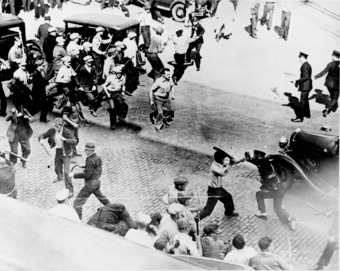
Teamsters clash with armed police in Minneapolis, 1934.
Members of the Teamsters union wielding pipes clash with armed police during a 1934 strike in Minneapolis.
13.5.2: Boycotts
Union boycotts are a form of industrial action by a trade union in support of a strike initiated by workers in another, separate enterprise.
Learning Objective
Differentiate between a trade dispute with a worker’s direct employer and “secondary action”
Key Points
- The term “secondary action” is intended to be distinct from a trade dispute with a worker’s direct employer, and so may be used to refer to a dispute with the employer’s parent company, its suppliers, financiers, contracting parties, or any other employer in another industry.
- In most countries there are limits on the purpose for which people can go on strike. In many English-speaking nations, restrictions have been placed on which organizations trade unions may strike against.
- Secondary action is illegal in the United States. It is banned by the Sherman Antitrust Act and by the Taft-Hartley Act, which amends the Wagner Act of 1935.
Key Terms
- agribusiness
-
Big business connected to agriculture, either owning or operating large scale farms, or catering to those who do.
- boycott
-
To abstain, either as an individual or group, from using, buying, or dealing with someone or some organization as an expression of protest.
- industrial action
-
In a workplace, a strike or other protest by workers.
Example
- Because farm laborers in the United States are not covered by the Wagner Act, the United Farm Workers’ (UFW) union has been able to legally use secondary boycotting of grocery store chains as an aid to their strikes against California agribusinesses and to their primary boycotts of California grapes, lettuce, and wine. The UFW’s secondary boycotts involved asking consumers to stop shopping at a grocery store chain until such time as the chain stopped carrying the boycotted grapes, lettuce, or wine.
Union Boycotts: Supporting Strikers
Union boycotts, or secondary action, is industrial action by a trade union in support of a strike initiated by workers in another, separate enterprise .
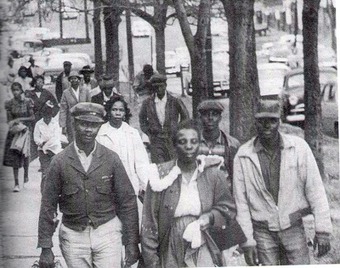
Union Boycotts
Also known as secondary action, is industrial action by a trade union in support of a strike initiated by workers in another, separate enterprise.
The term “secondary action” is intended to be distinct from a trade dispute with a worker’s direct employer, and so may be used to refer to a dispute with the employer’s parent company, its suppliers, financiers, contracting parties, or any other employer in another industry.
Going on Strike: Legal Limits
In most countries there are limits on the purpose for which people can go on strike, and in many English-speaking nations restrictions have been placed on which organisations trade unions may strike against. In the U.S. and U.K., workers can typically strike against their direct employer only.
In continental Europe, secondary action is generally lawful and the right to strike is seen as a part of a broader political freedom. Secondary action is illegal in the United States. It is banned by the Sherman Antitrust Act and by the Taft-Hartley Act, which amends the Wagner Act of 1935.
Because farm laborers in the United States are not covered by the Wagner Act, the United Farm Workers’ (UFW) union has been able to legally use secondary boycotting of grocery store chains as an aid to their strikes against California agribusinesses and to their primary boycotts of California grapes, lettuce, and wine. The UFW’s secondary boycotts involved asking consumers to stop shopping at a grocery store chain until such time as the chain stopped carrying the boycotted grapes, lettuce, or wine.
13.5.3: Lockouts
Employers are generally motivated to prevent, mitigate the impact of, and undermine strikes when they occur by using a variety of tactics.
Learning Objective
Explain how companies prevent and stop strikes
Key Points
- One of the weapons traditionally wielded by already established unions is strike action.
- Unions faced with a strikebreaking situation may try to inhibit the use of strikebreakers by a variety of methods.
- One method of inhibiting or ending a strike is firing union members who are striking, which can result in the elimination of the union, This is often referred to as union busting.
- At the federal level President John Kennedy, a Democrat, in 1962 issued Executive Order 10988, upgrading the status of unions of federal workers.
- In 2011 as states faced a growing fiscal crisis and the Republicans made major gains in the 2010 elections, public sector unions came under heavy attack in Wisconsin, Indiana, New Jersey and Ohio from conservative Republican legislatures.
- Traditionally, women had been under-represented in union organizing due to the belief that “it was a woman’s ‘nature’ to be a loyal ‘office wife'” and to not show disloyalty by joining a union. As the industrial sector began to decline more attention has turned to organizing women in white-collar service jobs, or what has been called the pink-collar sector. The increased membership of women has also shed new light on gender issues, with family issues and other women’s concerns gaining more legitimacy in the work place.
Key Terms
- Solidarity
-
A bond of unity between individuals, united around a common goal or against a common enemy, such as the unifying principle that defines the labor movement.
- picket line
-
The boundary created by striking workers, generally at the workplace entrance, which other workers are asked not to pass.
- strikebreaking
-
Activity intended to disrupt or end without an agreement a strike by workers.
Example
- The United Auto Workers’ numbers of automobile union members are representative of the decline in unions in the manufacturing sector: 1,619,000 active members in 1970, 1,446,000 in 1980, 952,000 in 1990, 623,000 in 2004, and 377,000 in 2010 (with far more retired than active members).
Union Tactics
Methods to Deal with Strikes
Most strikes called by unions are somewhat predictable; they typically occur after the contract has expired. However, not all strikes are called by union organizations. Some strikes have been called in an effort to pressure employers to recognize unions. Other strikes may be spontaneous actions by working people. Spontaneous strikes are sometimes called “wildcat strikes;” they were the key fighting point in May 1968 in France. Most commonly, they are responses to serious (often life-threatening) safety hazards in the workplace rather than wage or hour disputes, etc.
Whatever the cause of the strike, employers are generally motivated to take measures to prevent them, mitigate the impact, or to undermine strikes when they do occur.
Strike Preparation
Companies which produce products for sale will frequently increase inventories prior to a strike. Salaried employees may be called upon to take the place of strikers, which may entail advance training. If the company has multiple locations, personnel may be redeployed to meet the needs of reduced staff.
Companies may also take out strike insurance prior to an anticipated strike, to help offset the losses which the strike would cause.
One of the weapons traditionally wielded by already-established unions is strike action. Some companies may decline entirely to negotiate with the union, and respond to the strike by hiring replacement workers. This may create a crisis situation for strikers. Do they stick to their original plan and rely upon their solidarity, or is there a chance that the strike may be lost? How long will the strike last? Will strikers’ jobs still be there if the strike fails? Are other strikers defecting from the strike? Companies that hire strikebreakers typically play upon these fears when they attempt to convince union members to abandon the strike and cross the union’s picket line.
Unions faced with a strikebreaking situation may try to inhibit the use of strikebreakers by a variety of methods, establishing picket lines where the strikebreakers enter the workplace; discouraging strike breakers from taking, or from keeping strikebreaking jobs; raising the cost of hiring strikebreakers for the company; or employing public relations tactics. Companies may respond by increasing security forces and seeking court injunctions.
Strikebreaking
Some companies negotiate with the union during a strike; other companies may see a strike as an opportunity to eliminate the union. This is sometimes accomplished by the importation of replacement workers, strikebreakers, or “scabs. ” Historically, strike breaking has often coincided with union busting. It was also called “Black legging” in the early twentieth century, during the Russian socialist movement.
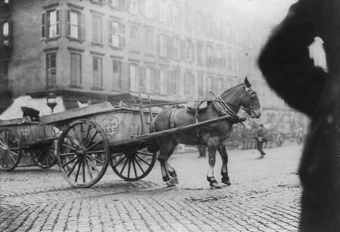
Strikebreaker
Strikebreaking tactics are often met with hostile reactions from strikers
Union Busting
One method of inhibiting or ending a strike is firing union members who are striking, which can result in elimination of the union. Although this has happened, it is rare due to laws regarding firing and “right to strike” having a wide range of differences in the United States, depending on whether union members are public or private sector. Laws also vary country to country. In the United States, it is legal to fire striking public sector employees if the strike is illegal. Conversely in the United Kingdom, “It is important to understand that there is no right to strike in UK law.” Employees who strike risk dismissal, unless it is an official strike (one called or endorsed by their union), in which case they are protected from unlawful dismissal and cannot be fired for at least 12 weeks.
Lockouts
Another counter to a strike is a lockout, the form of work stoppage in which an employer refuses to allow employees to work. Two of the three employers involved in the Caravan park grocery workers strike of 2003-2004 locked out their employees in response to a strike against the third member of the employer bargaining group. Lockouts are, with certain exceptions, lawful under United States labor law.
Violence
Historically, some employers have attempted to break union strikes by force. One of the most famous examples of this occurred during the Homestead Strike of 1892. Industrialist Henry Clay Frick sent private security agents from the Pinkerton National Detective Agency to break the Amalgamated Association of Iron and Steel Workers strike at a Homestead, Pennsylvania steel mill. Two strikers were killed, 12 wounded, along with 2 Pinkertons killed and 11 wounded. In the aftermath, Frick was shot in the neck and then stabbed by Alexander Berkman, surviving the attack, while Berkman was sentenced to 22 years in prison.
13.5.4: Trends in Labor-Management Relations
Labor-Management relations have been impacted by the decline in union participation, alongside the increase of globalization.
Learning Objective
Understand why unions are declining, both in the United States and elsewhere, and the impact this may have on labor-management relations
Key Points
- The most notable recent trend in management-labor relations is a decline in union participation.
- Unions have declined significantly in the United States since the 1950’s, representing less than 20% of the modern day workforce.
- Globalization and the outsourcing of many jobs, notably in manufacturing, has reduced labor union participation and created a barrier between the organization and the labor they utilize to produce.
Key Term
- deregulation
-
The act of reducing or removing legal or regulatory intervention on a specific issue.
The relationship between management and unions is complex. On the one hand, unions and management collaborate and come to agreement on how workers should be compensated, and what rights and safety measures must be observed to maintain a healthy working environment.
On the other hand, there is inherently some conflict of interest. Indeed, the foundations of unions is largely one of bringing workers together to ensure (and fight for) proper rights, compensation, and treatment by the organizations. As a result, there is some compromise involved in how unions and management negotiate.
Current Trends in Labor Unions
The most significant trend in the United States when considering labor unions is fairly simple. They are far less prevalent now than they used to be. The initial rise of labor unions in the United States occurred during the Great Depression (1930’s), which has steadily decreased over time. This decrease in labor union participation has also been seen internationally, particularly in recent years. This could be for a number of reasons, but the outcome is the same. Labor unions since the turn of the millennium only represent a small fraction of the U.S. workforce (as illustrated in the chart below).
The trends in labor unions are many, but particularly worthy of note are the impacts of globalization, decrease in manufacturing, and deregulation.
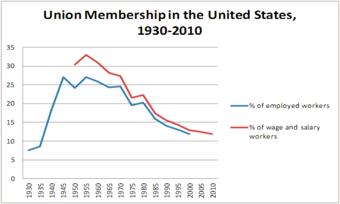
Union Membership
Lower union membership is an important trend in labor dynamics, reducing the conversation between organizations and unions overall.
Globalization
Union labor laws are domestic, which is to say that the rights of employees are protected by the national government where they reside. As a result, globalization offers the capability for businesses to exploit areas without unions (often with lower labor costs) while diminishing the bargaining power of unions domestically (wherever that may be).
Manufacturing
It’s also worth noting that many union-oriented industries have seen some declines in the United States. Manufacturing, for example, is often outsourced. With fewer employees in union-protected industries, it’s a natural trend that unions will represent a smaller portion of the overall national workforce.
Deregulation
Finally, politics and unions are interdependent. Some economists and researchers have noted that political approaches during the 1980’s created an impact on the ability for employers to diminish the power of unions. This supposition is supported by the decline of unions alongside the propensity for illegal firings during union campaigns (see chart below).

Illegal Union Firings (U.S.)
This chart illustrates the rise of illegal firings during union elections, notably rising in the 1980’s and continuing onwards from there. This is an important trend in the regulatory side of management and union relations.
Conclusion
All and all, management in modern times has seen a lower amount of participation in union negotiations on behalf of organizations. This is primarily reflected by lower union involvement in many industries, alongside the rise of globalization and outsourcing.
